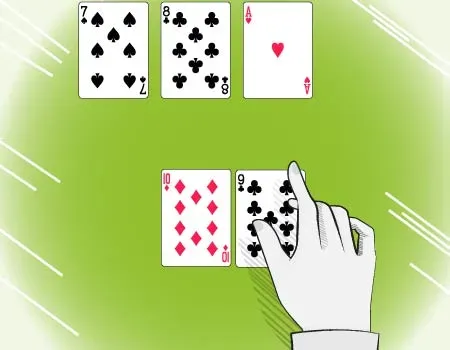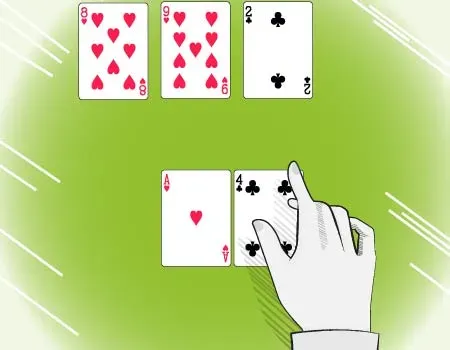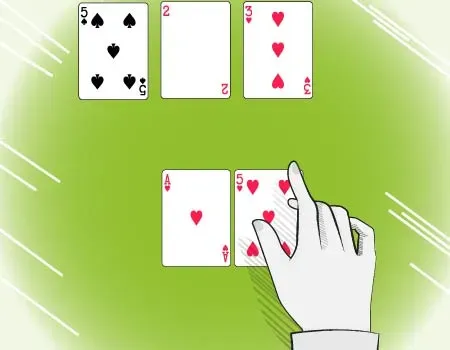THE ART OF SEMI-BLUFF IN POKER
In poker, a semi-bluff is a bet made on the flop or turn where a player doesn’t have a big value poker hand currently, but can still win the pot in one of two ways:
- They get their opponents to fold to their bet, awarding them the pot in the process.
- They can improve the strength of their hand on future streets and win at showdown anyway.

Flush draws and open ended straight draw are often hands that players can often opt to semi-bluff with, as they have little value when just a draw, but have decent potential of becoming a big hand if the right card hits.
Another example of a semi-bluff could include continuation betting on the flop with two overcards to the board, in which case the player could have up to 6 outs to get a higher pair than their opponent if their opponent flops or already has a lower pair.
Table of Contents
WHEN TO USE A SEMI-BLUFF
However, there are a few things you should look out for and/or take into consideration when choosing to semi-bluff:
- Fold Equity/Opponent’s Hand Weakness: Remember that when your opponent folds to your bet, this is always a positive result, especially when semi-bluffing! If you have a read that your opponent may be especially weak and will fold to aggression (a bet or a raise), then semi-bluffing through a bet or a raise becomes advantageous.
- Backdoor Equity: When someone refers to a “backdoor” in poker, they’re referring to hands that can be improved by hitting certain turn and river combinations. For example, if you have the Ace of Hearts and there are 2 hearts on the flop, you currently have a backdoor nut flush draw, as 2 more running hearts will give you a flush. While making backdoor draws are unlikely, they do give you additional valuable equity which can allow you to continue with semi-bluffing with aggression on select turns, put pressure on your opponents, and add an element of deception to your true hand value.

- Combo Draws: Semi-bluffs also can include extremely strong draws, such as those with 12 or more outs! Examples of these can include open-ended straight flush draws, pair + flush draws, pair + straight draws, and straight or flush draws with one or two overcards.
- Position: How you should play your draws will vary greatly depending on whether you’re in or out of position, relative to where your opponents are seated. When out of position, it can sometimes be favourable to play your strong draws fast against certain opponents and be happy with getting the money in on the flop. When in position, you have greater flexibility as to your options, as you always get to see how your opponent(s) act first.
- Building a Pot: Especially when deepstacked, it can be very advantageous to start building a pot early with your nut draws or well-concealed draws through semi-bluffing, especially when in position.
- Opponent Toughness and Tendencies: Against aggressive opponents, it can sometimes be advantageous to play passively with both your draws and strong made hands to balance out your calling range. (Let them build a pot for you.) Against players who cbet too frequently and/or who will not often put up a fight if you raise with a semi-bluff, it can be very profitable to raise with your draws! Against tougher opponents who often will bet strongly against you, you won’t be able to play passively with your draws all the time and will have to semi-bluff through raising at opportune times in order to show profits against these players.
- Raise Sizing a Semi-Bluff: Always take care in assessing stack to pot ratios (as well as the amount or size you should make your semi-bluffs). (Refer to “Choose Correct Bet Sizing” in Section 5 of this eBook for more info on how often your opponent needs to fold to your raise and corresponding raise size for you to be profitable.) In a semi-bluff, your profitability will be calculated by a sum of the amount you win when your opponent folds as well as how much you win when you hit your hand and win at showdown (multiplied by the approximate odds of each happening).
SEMI-BLUFF EXAMPLE
You have A♥5♥ in the big blind. The button has a 50bb stack and opens to 3bb. You opt to call as you wouldn’t want to potentially face a 4bet, to which you’d probably have to fold.
The flop comes 5♠2♥3♥. In addition to having TPTK (top pair, top kicker), you also have an inside straight-flush draw. You check to your opponent, who continuation bets ½-pot. You decide to check-raise your hand for a few reasons:

- You Have Strong Equity: You have a very strong draw! Even if all the money goes in on the flop, you may still be the favourite in many situations. Against 77-KK, you have about 59% equity. Against 66, you have about 50% equity. Against a weaker flush draw, such as KQ of hearts, you’re about an 82% favourite. Against a set, you still have about 37% equity. Taking all the various poker combinations, your opponent could have into account, raising on the flop here becomes profitable because:
- You could win the current pot by getting your opponent to fold.
- You have decent equity against his value range if he decides to call or shove.
- You’re Out of Position: It can be very difficult to play profitably and soundly with a strong draw when out of position due to having to act first. To limit our losses from the blinds (as the blinds are generally “losing” positions over the long term for players), it’s important to raise hands with good equity (such as this) and make other creative +EV plays over time. It’s inadvisable to play strong draws like this passively against a (weaker) button range because they could have little flopped equity, but outdraw you on the turn or river if you let them “get there” cheaply.
- You Get Your Opponent to Define His Range: While the primary purpose of a raise should never be for information, this is one of the secondary effects that raising provides. Raising here would also get your opponent to fold weaker hands that could out-turn us and subsequently put our strong draw in bad shape out of position (i.e. our opponent having QJ if a Jack or a Queen hit the board on the turn or river).
METAGAME CONSIDERATIONS
The metagame consists of the whole inner dialogue conversation one has with him
or herself during a hand involving, “He knows that I know that
 he knows that I know,” and so on and so forth. Certain situations from previous hands or taking player tendencies into account can make particular players play differently than they otherwise would in various situations.
he knows that I know,” and so on and so forth. Certain situations from previous hands or taking player tendencies into account can make particular players play differently than they otherwise would in various situations.
In the above example, perhaps we had made this check-raise in the past against this opponent on a similar board with 77 and folded and showed when the opponent re-raised us back. If we play this strong equity hand the same way as we did with our 77 earlier (by check-raising the flop), our opponent might think he could semi-bluff and get us to fold again to a shove.
In fact, imagine if he considers doing this with AK! His thinking would be that he has outs to a wheel as well as two overs to the board, and if he 3bet jams, he could get us to fold a better hand again
on the flop (like a medium pocket pair)!
In reality, against our currently holding, he would only have 6% equity to win the pot outright against us if he shoved here.
Always take game-flow and metagame considerations into account when deciding how to act.
